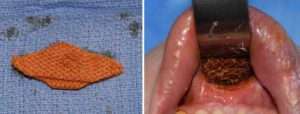Chin ptosis is defined as a malpositioning of the soft tissue chin pad over the front end of the chin bone. The soft tissue chin pad has fallen off the end of the bone causing a potential multitude of symptoms from a lower lip sag, excessive tooth show to, at the least, an unaesthetic fullness below the chin. It can be caused by a variety of surgical procedures including chin implant removal and intraoral chin bone shaving reduction as two very common ones.
The treatment of chin ptosis has been done by several techniques with the fundamental concept of elevating the mentalis muscle and creating a firm bony attachment that will support the resuspended soft tissue pad. This primarily depends on creating a solid bony fixation point that can adequately hold anchoring sutures. An adjunctive aid in some cases is the use of a chin implant which serves as a platform on which the soft tissue chin pad can rest as well and act as a stop fro recurrent chin pad descent.
A chin implant that has a textured or porous surface is helpful in chin ptosis as the tissue adhesion serves as additional soft tissue pad support. While porous polyethylene (Medpor) is the most well known chin implant that creates overlying soft tissue adhesion, it is not the only one. Less well known but equally effective is mersilene mesh, a chin implant that is fabricated from a hernia repair mesh. By creating multiple layers of material and suturing it together, a very porous implant is created in any shape and thickness one desires.

Another implant biomaterial that can be used in a similar fashion for its softvtissue adhesion capability is that of ePTFE or Goretex. It can be similarly easily cut and placed and offers some soft tissue adhesion capability that is less aggressive than that of a mesh implant.
Dr. Barry Eppley
Indianapolis, Indiana


